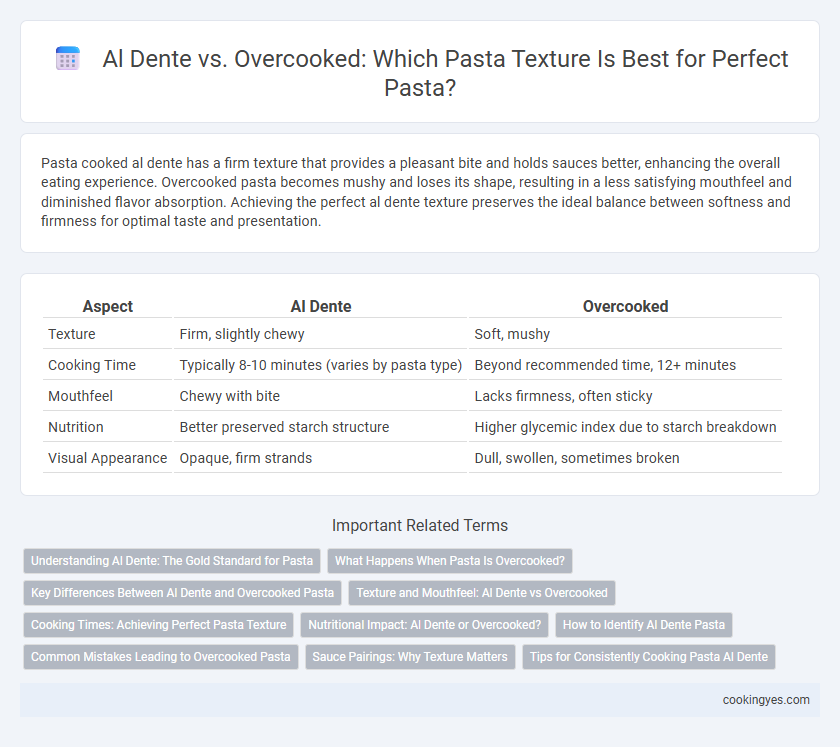Pasta cooked al dente has a firm texture that provides a pleasant bite and holds sauces better, enhancing the overall eating experience. Overcooked pasta becomes mushy and loses its shape, resulting in a less satisfying mouthfeel and diminished flavor absorption. Achieving the perfect al dente texture preserves the ideal balance between softness and firmness for optimal taste and presentation.
Table of Comparison
| Aspect | Al Dente | Overcooked |
|---|---|---|
| Texture | Firm, slightly chewy | Soft, mushy |
| Cooking Time | Typically 8-10 minutes (varies by pasta type) | Beyond recommended time, 12+ minutes |
| Mouthfeel | Chewy with bite | Lacks firmness, often sticky |
| Nutrition | Better preserved starch structure | Higher glycemic index due to starch breakdown |
| Visual Appearance | Opaque, firm strands | Dull, swollen, sometimes broken |
Understanding Al Dente: The Gold Standard for Pasta
Al dente pasta, cooked to a firm yet tender texture, preserves the optimal bite and enhances flavor absorption, making it the gold standard for pasta preparation. Overcooked pasta becomes mushy and loses its structural integrity, resulting in a bland and soggy dish that diminishes the pasta-eating experience. Mastering al dente ensures perfect texture, optimal nutrient retention, and complements sauces without overpowering the dish.
What Happens When Pasta Is Overcooked?
Overcooked pasta loses its firm, chewy texture and becomes mushy due to the breakdown of starches and gluten. Excessive cooking causes the pasta to absorb too much water, resulting in a gummy, sticky consistency that diminishes the overall flavor and mouthfeel. Maintaining the ideal al dente texture preserves the pasta's structural integrity, enhancing both taste and presentation.
Key Differences Between Al Dente and Overcooked Pasta
Al dente pasta offers a firm, slightly chewy texture that enhances the overall eating experience by maintaining the integrity of each strand or piece. Overcooked pasta becomes mushy and loses its shape, resulting in a swollen, limp texture that can detract from the dish's quality. The key difference lies in starch gelatinization and moisture retention, where al dente pasta retains firmness due to partial starch gelatinization, while overcooked pasta absorbs excess water, leading to a soggy consistency.
Texture and Mouthfeel: Al Dente vs Overcooked
Al dente pasta offers a firm, slightly resistant texture that provides a satisfying bite and enhances the pasta's ability to hold sauces, resulting in a balanced mouthfeel. Overcooked pasta becomes soft and mushy, losing structural integrity and creating a slippery, less enjoyable texture that can dilute the flavor experience. The contrast in texture between al dente and overcooked pasta significantly impacts the overall enjoyment and culinary quality of a dish.
Cooking Times: Achieving Perfect Pasta Texture
Cooking times play a critical role in achieving the perfect pasta texture, with al dente pasta typically requiring 8 to 10 minutes of boiling depending on the type and thickness of the pasta. Overcooked pasta becomes mushy and loses its firmness, negatively affecting the mouthfeel and overall dining experience. Monitoring precise cooking times and tasting pasta just before the recommended duration ensures optimal al dente texture, characterized by a slight resistance to the bite.
Nutritional Impact: Al Dente or Overcooked?
Al dente pasta retains a lower glycemic index due to its firmer texture, which slows starch digestion and promotes better blood sugar control. Overcooked pasta breaks down more rapidly, leading to quicker glucose absorption and potential spikes in insulin levels. Nutritionally, al dente pasta supports sustained energy release and improved digestion compared to softer, overcooked varieties.
How to Identify Al Dente Pasta
Al dente pasta is identified by a firm texture with a slight resistance when bitten, avoiding the mushy softness of overcooked varieties. The surface appears cooked but the center maintains a subtle chewiness, ensuring optimal absorption of sauces and enhanced flavor. Testing by tasting pasta a minute or two before the package's recommended cooking time often achieves the perfect al dente consistency.
Common Mistakes Leading to Overcooked Pasta
Common mistakes leading to overcooked pasta include cooking for too long beyond the package instructions and failing to test pasta a minute or two before the suggested cooking time. Using excessive water boiling temperatures without monitoring the cooking process can cause pasta to become mushy instead of al dente. Stirring infrequently or rinsing pasta with cold water after draining also contributes to a loss of ideal texture by removing surface starch that helps maintain firmness.
Sauce Pairings: Why Texture Matters
Al dente pasta, with its firm texture, holds sauces better by providing resistance that allows the sauce to cling to each strand, enhancing flavor absorption. Overcooked pasta becomes soft and mushy, causing sauces to slip off and resulting in a less satisfying taste experience. Choosing the right pasta texture is essential for optimal sauce pairing, as firmer pasta complements chunky, hearty sauces while softer pasta suits lighter, cream-based sauces.
Tips for Consistently Cooking Pasta Al Dente
To consistently cook pasta al dente, start by boiling water with a generous amount of salt to enhance flavor and prevent sticking. Use the package's recommended cooking time as a guideline, but begin checking for firmness 2 minutes earlier by tasting the pasta; it should be tender yet still slightly firm to the bite. Immediately drain and rinse briefly with cold water to stop cooking, reserving some pasta water to adjust sauce consistency if needed.
Al dente vs overcooked for pasta texture Infographic

 cookingyes.com
cookingyes.com